Older Revision of Experimental Canon BP511 Dummy Battery Interface
Revision: 20071128_110824 | All Revisions
Experimental Canon BP511 Dummy Battery Interface
Quite a while back, I showed you how to take apart the Canon BP511 battery pack in the "Canon BP-511 Disassembly" article. In that article, I wanted to do more with the battery, perhaps turning it into a dummy battery interface. I finally done that today. In this article, I will show you how I turned my dead Canon BP511 into a dummy battery interface for experimental purposes.
After disassembly the battery pack, you'll find that the charging circuit board and the battery cells firmly soldered to the BP511 electrical contact pins. To remove the circuit board and battery cells, you'll need a soldering iron and a desoldering tool. I prefer the Vacuum Desoldering Tool. You can find it in the "Related Links" section below.
Use your soldering iron to heat the solder patch where each electrical contact is soldered to the circuit board. There are four electrical contacts. Use the vacuum desoldering tool to suck the solder fluid away. Then you'll be able to remove the battery cells and the charging circuit board from the plastic case. (see photo below). While your at it, desolder the charging circuit board so that you can separate it from the battery cells. there are three electrical contacts to desolder.
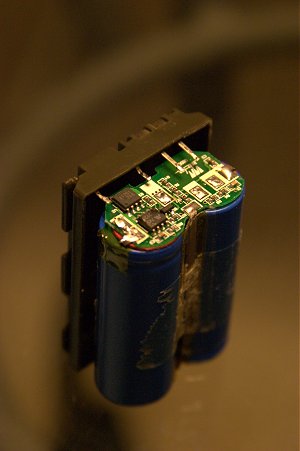
To easily interface to this experimental dummy battery pack, I decided to solder a 9-volt battery snap contact to the dummy battery electrical contacts (see photo below). You can find the 9-volt battery snap connector at your local Radio Shack store. Have a ohm meter handy to figure out which wire goes to which connector. You'd be surprised what you'd find. Only the + and - BP511 electrical contacts are used. The black wire goes to the - contact on the BP511, while the red wire goes to the + contact.
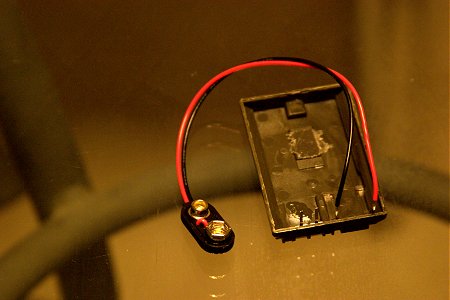
Tip
If you are wiring the 9-volt snap connector to an actual battery cell, then the black wire goes to the + contact, while the red wire goes to the - contact. I'll leave it up to you as an exercise to figure out why this is the case.
I drilled out two small holes on the BP511 plastic case to pass the 9-volt battery snap connector through (see photo below). I used the smallest drill in my tool set.
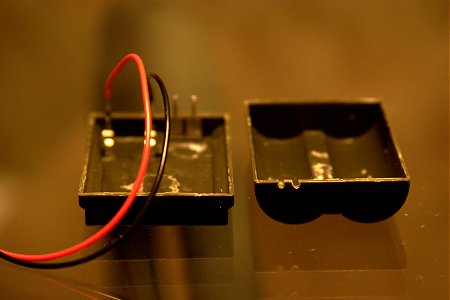
After slicing through the battery pack, as shown in the "Canon BP511 Disassembly" article, the plastic case wouldn't be able to hold itself together. I placed the dead battery cells back in and routed the 9-volt snap connector wires around the battery cells. The dead battery cells gave the dummy battery pack some weight and helped hold the plastic case together.
While working on this modification, lots of things ran thought my mind. Things like: 1) what do I want to do with this dummy battery interface? 2) how many alkaline batteries does it take to power my Canon EOS digital SLR camera? 3) What can I fit inside the BP511 case? Got any ideas, please share by posting in the "Comments & Discussion" thread.
Experimenting with the Dummy Battery Pack
To answer question 2, I looked at the bottom label of my Canon EOS D30 and Canon EOS Digital Rebel. The label usually shows the power requirement specification. I haven't looked at the labels in years, because I have vertical battery grips attached to the bottom of all my DSLR cameras; covering the labels. It turned out that the Canon EOS DSLR cameras can handle DV voltage up to 8.1 volts (see photo below). Since the BP511 battery pack is rated at 7.4 volts, the Canon EOS DSLR cameras can handle electricity between 7.4 to 8.1 volts. I have a suspicion that it can even handle 7.2 volts (6 NiMh or 6 NiCd battery cells).
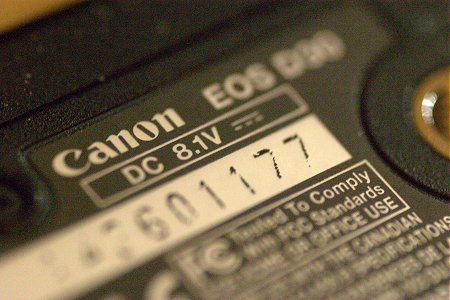
Being able to support a range between 7.2 volts and 8.1 volts gave me a lot of leeway. Because it means that I can also power the camera with five alkaline batteries. I jury-rigged several battery holders and several 9-volt snap connectors together to give it a try (see photo below). My Digital Rebel was able to turn on and initialize. I auto-focused and snapped away. It worked fine! Next step is to figure out how long the batteries will last. Stay tuned.
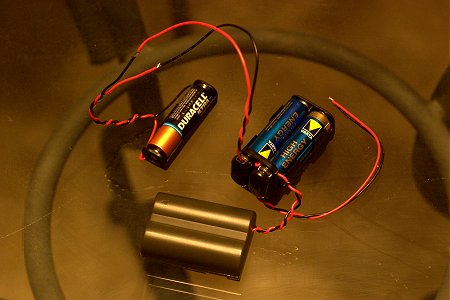
Related Links
352 Users Online
|
$10000-above $5000-$9999 $2000-$4999 $1000-$1999 $500-$999 $200-$499 $100-$199 $50-$99 $25-$49 $0-$24 Gift Certificate |
|




